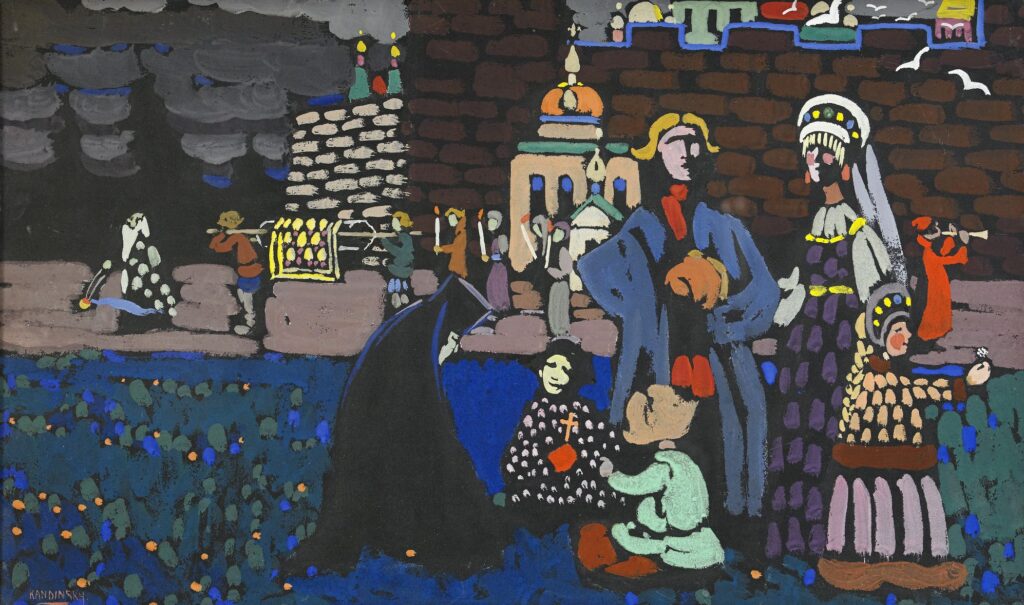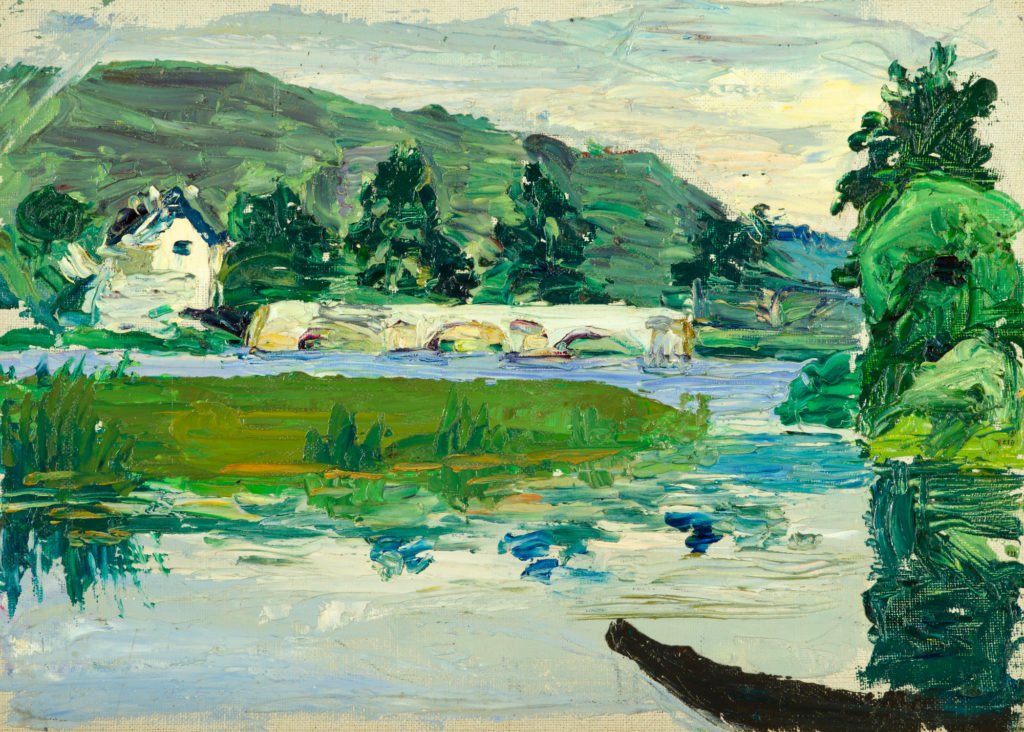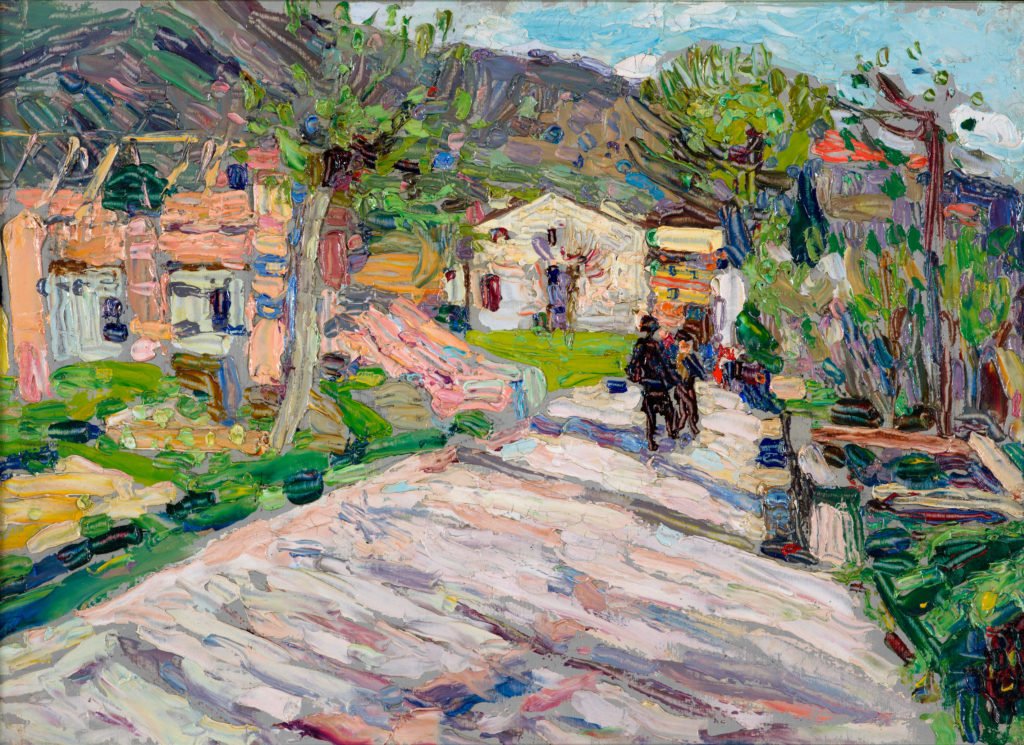Wassily KANDINSKY
(Moscow, 1866 – 1944, Neuilly- sur-Seine)
Vanitas vanitatum
1907
Gouache on paper laid down on board, 29 x 48.8 cm
Signed lower left: “Kandinsky"
Executed in 1907, Vanitas perfectly exemplifies the folk and fairytale period in W.Kandinsky’s artistic career. The liberated approach to colour drawn on Fauvism and the Nabis, encouraged the artist to employ the divisionist brush-stroke, with the colour being used at its maximum intensity. The use of bright, accurately chosen hues testifies to the role of pure colour getting more important in Kandinsky’s art. As in music, Kandinsky’s art has many voices. The tones of colour create a form on canvas. The artist described his associations with colour and music in books that are still of great interest to those who explore the art of the Russian avant-gardist.
The “mosaic” of striking colors against a black (dark) background in previous works by Kandinsky reached its full formal and conceptual expression in “Colorful Life.” The picture’s title in Russian uses the word pyostry (German – Bunt), in the senses of “multi-colored” (“multi-colored hills” in a northern landscape; “multi-colored ornaments” in peasant frescoes) and “multi-faceted” (“multi-faceted complexity” of Russia).
The actual subject of the picture lies in the diversity of the vital paths depicted. The mystical spiritualization of earthly, bodily life should combine the multi-colored world of paganist wisdom with Christian spirituality and fuse “the joyous colors of life” into “the unified white color of Resurrection.” [Merezhkovsky 1998: 147-148].
Provenance:
Galerie Der Sturm, Berlin, 1912;
Gummesons Konstgalleri, Stockholm, 1916 – mid-1930s;
Private collection, Stockholm;
Important private collection, Zürich, Switzerland
Bibliography:
Album Kandinsky 1901–1913, Der Sturm 1913, avbildad, no. 343;
Will Grohmann, Wassily Kandinsky. Life and Work, New York, 1958;
Vivian Endicott Barnett, Kandinsky och Sverige, Malmö 1989, no. 219;
Vivian Endicott Barnett, Kandinsky Watercolours, Catalogue Raisonné,1900–1921, London, 1992, no. 216, with color ill.;
Magdalena M. Moeller. Der frühe Kandinsky 1900–1910, exposition catalogue, 1994, no. 74, reproduced;
Kunstberatung Zurich. Old masters and Modern art catalogue: private treasures, Zurich, 2019
Exhibitions:
Société des Artistes indépendants, Paris 1907;
Salon 2, 1910-1911, International art exhibition, Odessa, Vladimir Izdebsky, 1910;
Kandinsky, Berlin, Galerie Der Sturm, 1912;
Kandinsky, Stockholm, Gummesons Konsthandel, 1916;
Kandinsky, Gummeson konsthall, 1932;
Kandinsky, Stockholm, Moderna Museet, 1965;
Kandinsky och Sverige, Stockholm/Malmö, Malmö Konsthall / Moderna Museet, 1989–1990;
Der frühe Kandinsky 1900 – 1910 (Seine frühen Jahre), Brücke Museum, Berlin/Kunsthalle Tübingen, 1994–1995;
Wassily Kandinsky – de ryska åren, Millesgården, Lidingö, 2001;
PAM – Salon Point Art Monaco – 2015;
Exhibition of Russian avant-garde paintings. Kandinsky and his contemporaries. On the 150th Anniversary of the Birth of Wassily Kandinsky. 16 December, 2016 – 31 December, 2017, ‘Art Centre. Moscow’, Moscow, Russia
Masterpiece London – 2017
La Biennale Paris – GRAND PALAS – 13 – 17 September 2019





